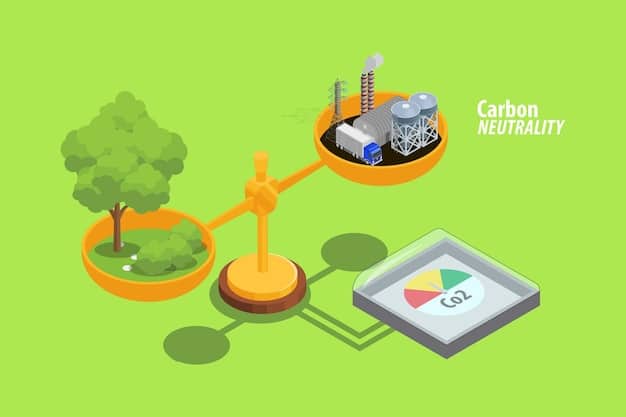Carbon Capture: A Key to US Climate Goals by 2050?

Carbon capture and storage (CCS) is poised to play a crucial role in the US meeting its ambitious climate goals by 2050, offering a pathway to significantly reduce carbon emissions from industrial processes and power generation, while also potentially enabling carbon removal technologies.
The United States has set ambitious goals to combat climate change, aiming for a net-zero emissions economy by 2050. A key technology in achieving these goals is carbon capture and storage (CCS), a process that captures carbon dioxide emissions from sources like power plants and industrial facilities, preventing them from entering the atmosphere.
Understanding Carbon Capture and Storage (CCS)
Carbon capture and storage (CCS) is a suite of technologies designed to prevent large quantities of carbon dioxide (CO2) from reaching the atmosphere. It involves capturing CO2 from sources such as coal-fired power plants, industrial facilities, and even directly from the air, then transporting it to a storage site, where it is injected deep underground into geological formations for permanent storage.
The Three Main Stages of CCS
The CCS process can be broken down into three main stages: capture, transport, and storage. Each stage has its own set of challenges and opportunities.
- Carbon Capture: This involves separating CO2 from other gases produced by industrial processes or power generation. Different capture technologies exist, including pre-combustion capture, post-combustion capture, and oxy-fuel combustion.
- Carbon Transport: Once captured, the CO2 needs to be transported to a suitable storage site. This is typically done via pipelines, but other methods, such as trucks and ships, can also be used.
- Carbon Storage: The final stage involves injecting the captured CO2 deep underground into geological formations, such as depleted oil and gas reservoirs, saline aquifers, or unmineable coal seams. The storage sites must be carefully selected and monitored to ensure that the CO2 remains safely contained.
CCS technologies have the potential to significantly reduce carbon emissions from the industrial and power sectors, providing a crucial tool for mitigating climate change. However, the widespread deployment of CCS faces challenges related to cost, infrastructure development, and public acceptance. 
CCS: A Key Component of US Climate Strategy
The US government has recognized the importance of CCS in achieving its climate goals and has implemented policies and programs to support its development and deployment. These include tax credits, funding for research and development, and regulatory frameworks for carbon storage.
Government Support for CCS
The Bipartisan Infrastructure Law and the Inflation Reduction Act have provided significant funding for CCS projects in the US. These investments are aimed at accelerating the development and deployment of CCS technologies, reducing their costs, and demonstrating their effectiveness on a large scale.
These policies create financial incentives for companies to invest in CCS projects and support the development of the necessary infrastructure. The government also plays a role in ensuring that CCS projects are conducted safely and responsibly, with robust monitoring and verification protocols.
The Potential Impact of CCS on US Emissions
The widespread adoption of CCS technologies has the potential to significantly reduce US carbon emissions. Studies have shown that CCS could capture hundreds of millions of tons of CO2 per year by 2050, contributing significantly to the country’s emission reduction targets.
CCS in Different Sectors
CCS can be applied to a variety of sectors, including power generation, industry, and even directly from the atmosphere through direct air capture (DAC) technologies.
- Power Generation: CCS can be retrofitted to existing coal-fired power plants or integrated into new natural gas power plants to capture CO2 emissions.
- Industrial Sector: Many industrial processes, such as cement and steel production, generate significant amounts of CO2. CCS can be used to capture these emissions and prevent them from entering the atmosphere.
- Direct Air Capture (DAC): DAC technologies capture CO2 directly from the air, offering a way to remove existing CO2 from the atmosphere. CCS is essential for the final storage of the captured CO2.
By deploying CCS across different sectors, the US can significantly reduce its overall carbon footprint and make progress towards its climate goals. DAC can be a crucial part of the fight to net zero, but is more costly.
Challenges and Opportunities for CCS Deployment
While CCS holds great promise, its widespread deployment faces a number of challenges, including high costs, infrastructure requirements, and public perception. Overcoming these challenges is crucial for realizing the full potential of CCS in meeting US climate goals.
Cost Considerations
The cost of CCS technologies remains a significant barrier to their widespread adoption. Capturing, transporting, and storing CO2 can be expensive, and these costs need to be reduced to make CCS economically viable as some industries cannot afford it.
Infrastructure Needs
The deployment of CCS requires the development of extensive infrastructure, including pipelines to transport CO2 and storage sites for its permanent disposal. Building this infrastructure will require significant investment and coordination.
The establishment of new infrastructure involves huge investments, time and public support. In turn, this highlights the need for CCS technologies such as DAC.
The Path Forward for CCS in the US
To maximize the role of CCS in meeting US climate goals, a number of steps need to be taken. These include continued government support, technological innovation, and public engagement.
Government Support and Incentives
Continued government support, through tax credits, research funding, and regulatory frameworks, is essential for driving the development and deployment of CCS technologies.
Technological Innovation
Investing in research and development to improve CCS technologies and reduce their costs is crucial. This includes developing more efficient capture methods, finding new storage sites, and improving monitoring technologies.
By addressing these challenges and seizing these opportunities, the US can ensure that CCS plays a central role in its transition to a low-carbon economy. 
CCS and the Broader Energy Transition
CCS is not a silver bullet, but rather one component of a broader strategy for decarbonizing the US economy. It needs to be integrated with other technologies and policies, such as renewable energy, energy efficiency, and electrification.
Integrating CCS with Renewable Energy
CCS can complement renewable energy sources by providing a way to reduce emissions from fossil fuel-based power plants during the transition to a fully renewable energy system.
- Backup Power: CCS can enable fossil fuel plants to provide backup power when renewable energy sources are not available, ensuring a reliable electricity supply.
- Hybrid Systems: CCS can be integrated into hybrid power plants that combine renewable energy with fossil fuels, reducing overall emissions.
Integrating CCS with other decarbonization strategies can create a more resilient and cost-effective path to achieving US climate goals. CCS is part of decarbonisation but is ultimately finite due to its need for geological space.
| Key Point | Brief Description |
|---|---|
| 🏭 CCS Potential | CCS can cut industrial and power sector emissions. |
| 💰 Gov Support | Incentives boost CCS projects and infrastructure. |
| 🌍 Emission Cuts | CCS can capture millions of tons of CO2 by 2050. |
| 📈 Key Steps | Gov support, innovations, engage the public are key. |
Frequently Asked Questions (FAQ)
What is CCS?
▼
CCS, or carbon capture and storage, is a technology that captures carbon dioxide (CO2) from sources like power plants and industrial facilities and stores it underground to prevent it from entering the atmosphere.
▼
The main stages of CCS are carbon capture, where CO2 is separated from other gases; carbon transport, usually via pipelines; and carbon storage, where the CO2 is injected into geological formations.
▼
CCS can significantly reduce carbon emissions from the power and industrial sectors, helping the US achieve its emission reduction targets and transition to a net-zero emissions economy by 2050.
▼
Some major challenges to CCS deployment are the high costs associated with the technology and a need for development of significant infrastructure to transport and store CO2.
▼
Direct air capture (DAC) is a technology that captures CO2 directly from the atmosphere allowing removal of pre-existing atmospheric carbon dioxide to reduce the abundance of greenhouse gasses.
Conclusion
In conclusion, carbon capture and storage (CCS) is poised to play a vital part in the US strategy to reach its climate goals by 2050. While there are challenges to overcome, including costs and infrastructure, the potential benefits of CCS in reducing emissions from key sectors make it a crucial technology to develop and deploy as part of all paths to net zero.





